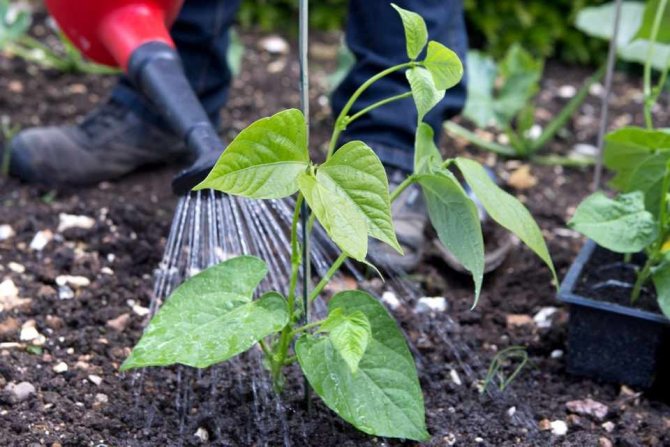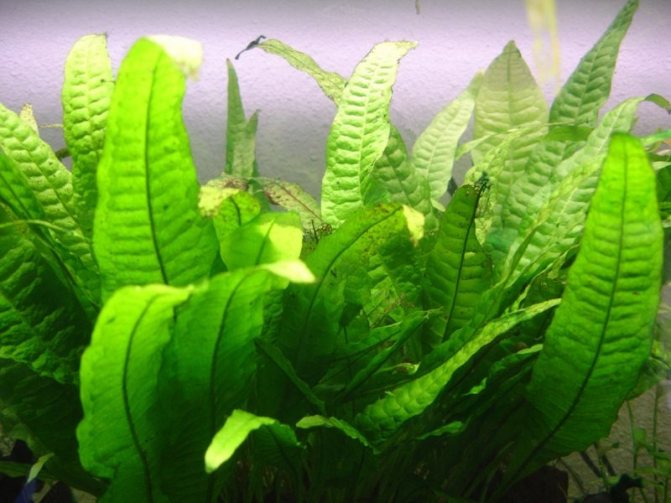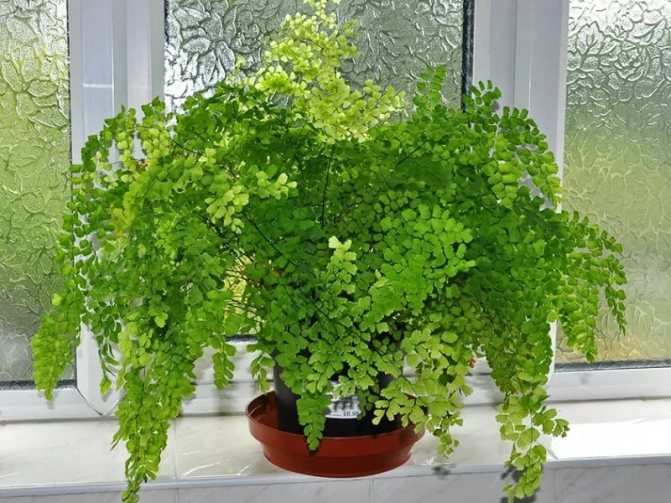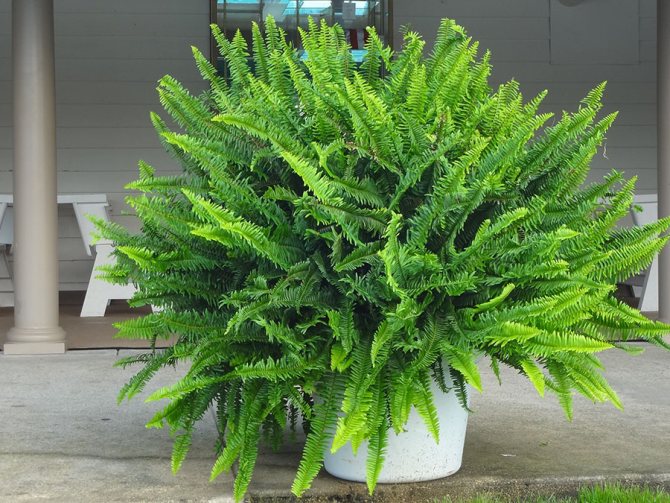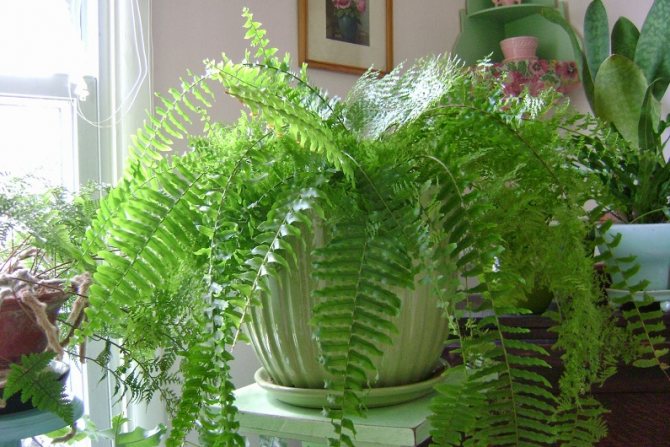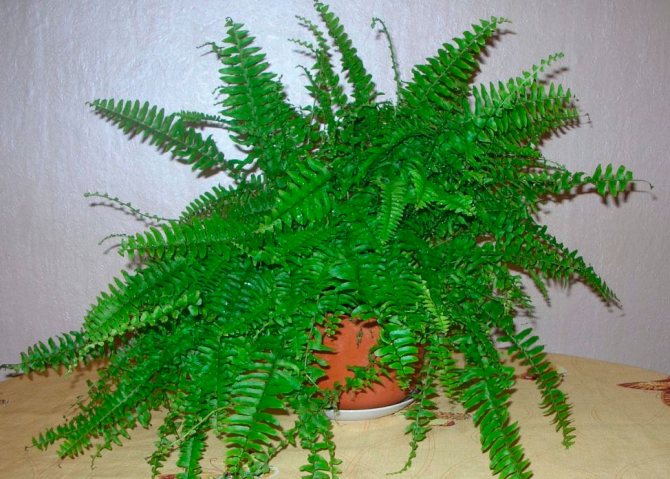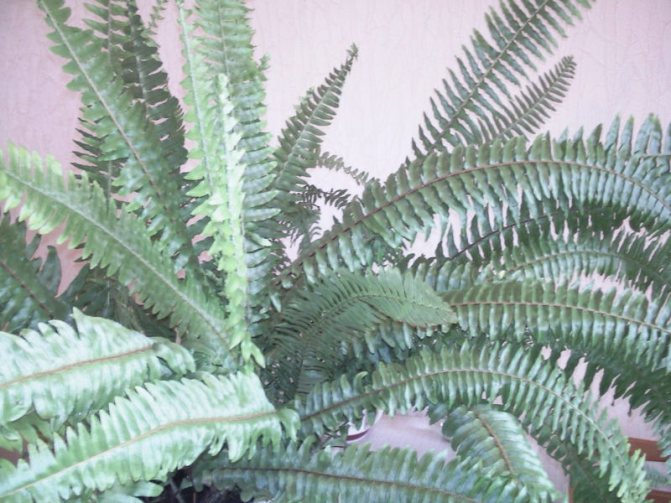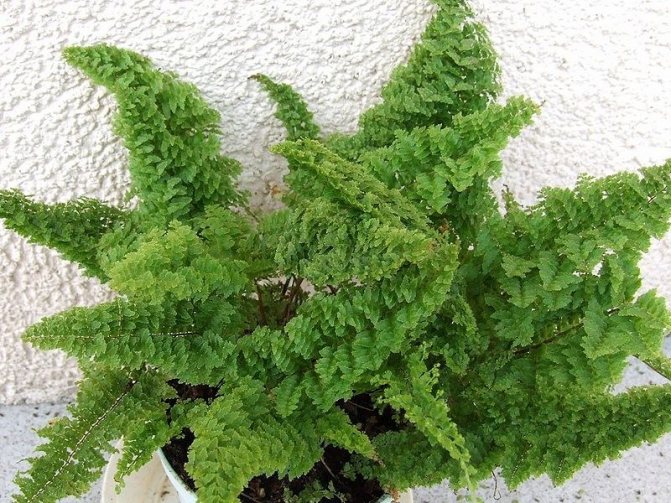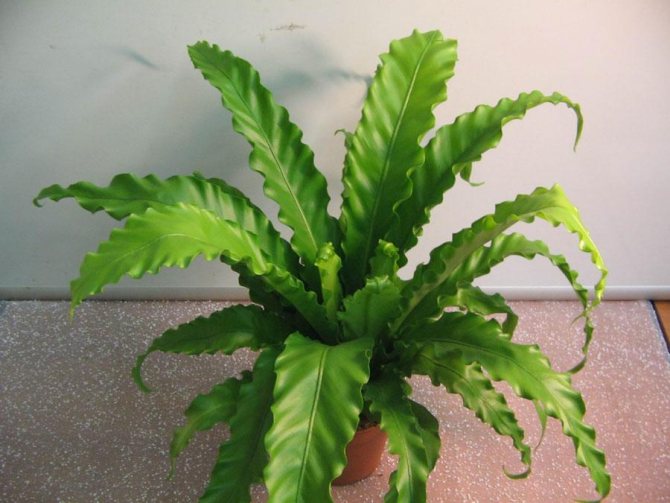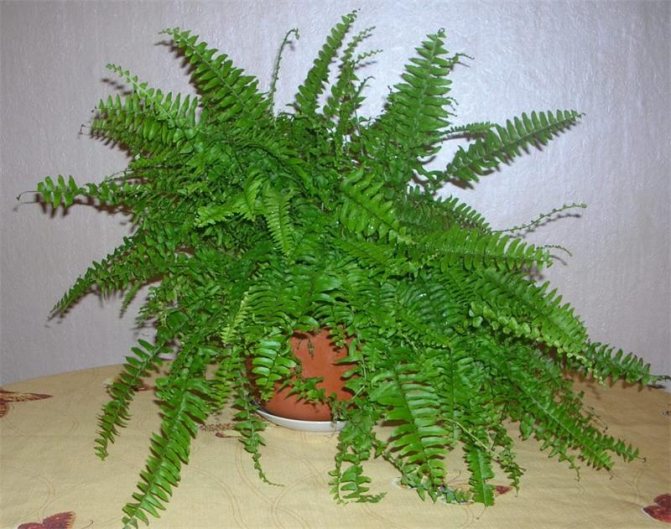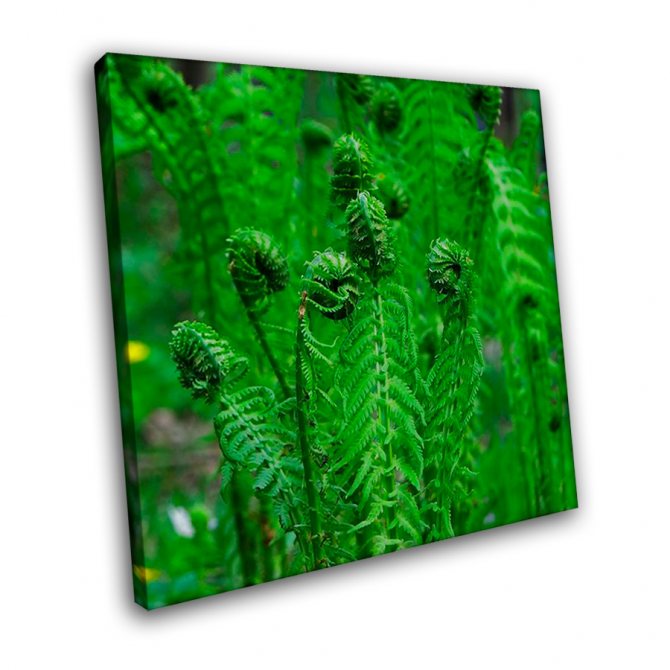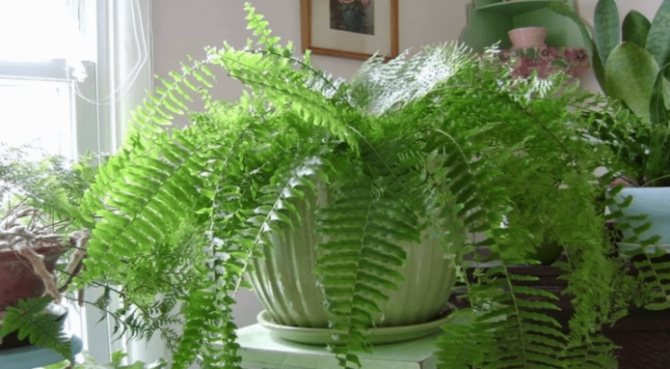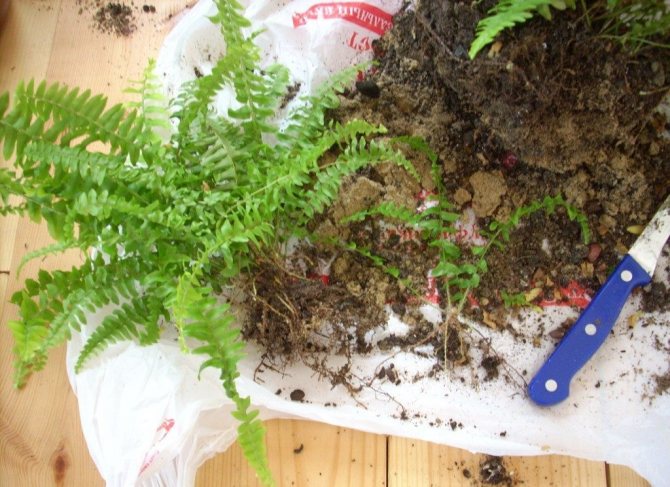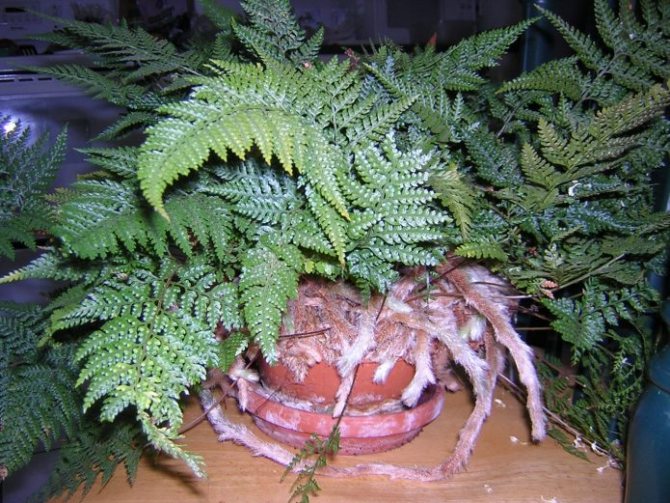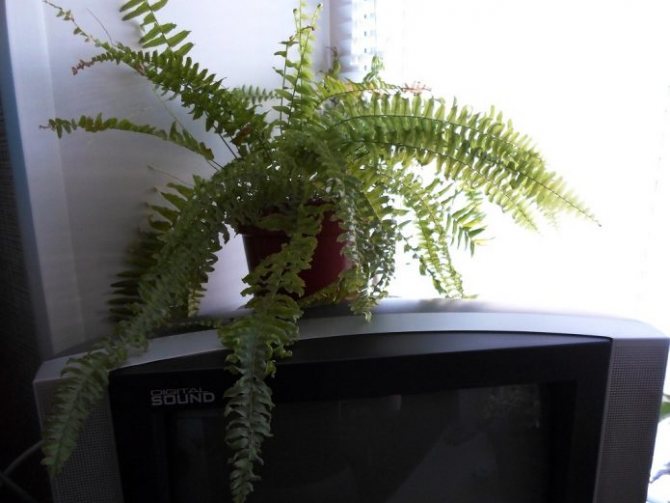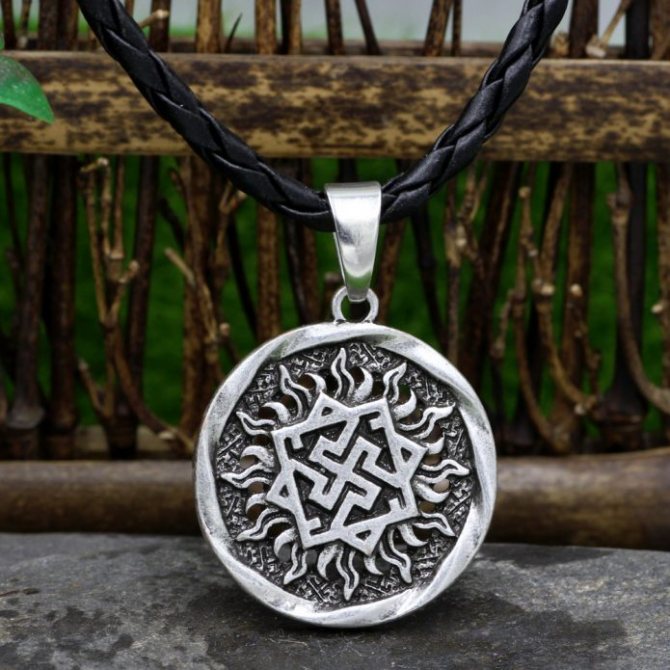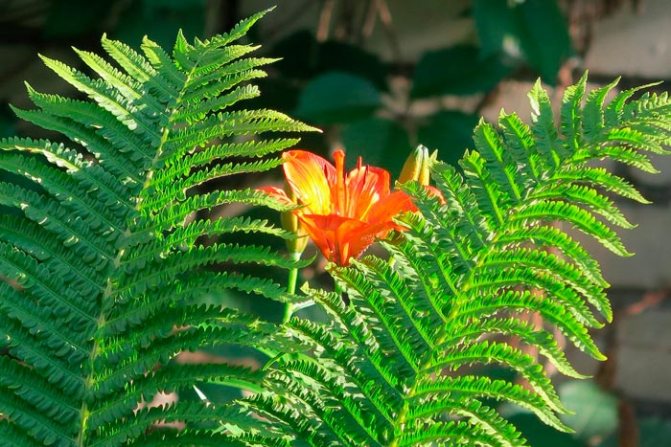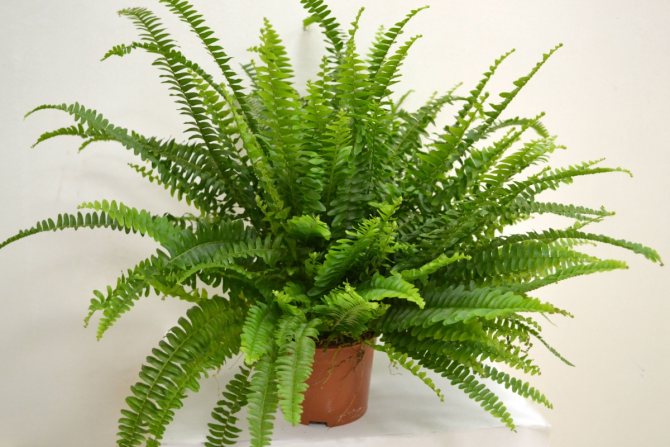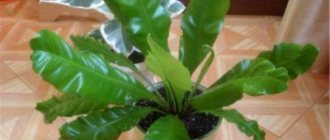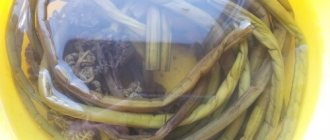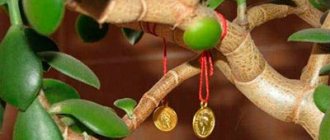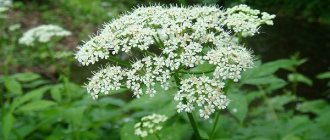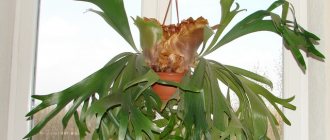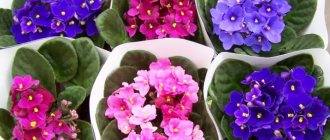/ Signs / Is it possible to keep a fern at home
0
8114
Article rating
Many people grow fern at home or on their personal plot, and hardly anyone thinks about whether it can be kept at home or should be moved to the office, and what signs and superstitions are associated with it.
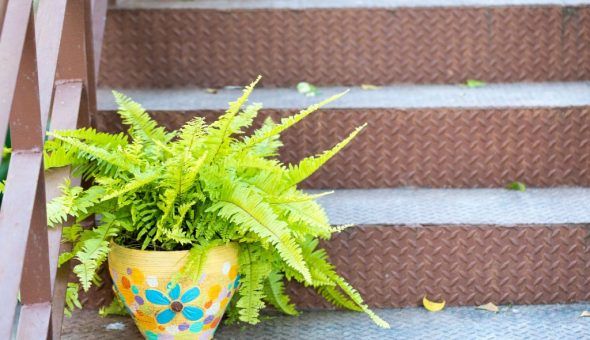
Fern house
Fern: beneficial properties for the human body and contraindications
Among the variety of indoor and garden plants, flower growers often prefer fern. After all, it has spreading leaves of a juicy green color and feels great at home on the windowsill.
In addition to its aesthetic appearance, the plant cleans the air well. Therefore, it can be seen not only in residential buildings and apartments, but in public premises - kindergartens, hospitals and schools.
How is fern useful for humans? It has a lot of healing properties and is rich in composition, thanks to which it treats many diseases and promotes weight loss. These qualities allow the plant to be used in cooking and folk medicine.
What it is
Thanks to its beautiful openwork leaves, rich green color, unpretentiousness to the conditions of detention, the fern has become a favorite among domestic plants. There are more than ten thousand varieties of it. The following types of indoor fern are grown:
- Maidenhair.
- Bracken.
- Male shieldworm.
- Nephrolepis.
- Ostrich.
By origin, it is a forest plant, therefore it loves shade and warm moist air. Water it twice a week with warm water to keep the soil moist. If the indoor air is dry, irrigate the leaves. The plant does not like drafts and cold. Optimal temperature for him 20 ° C... When placing a flower on a windowsill, direct sunlight may fall on it. From this, the plant withers, the leaves take on a faded appearance.
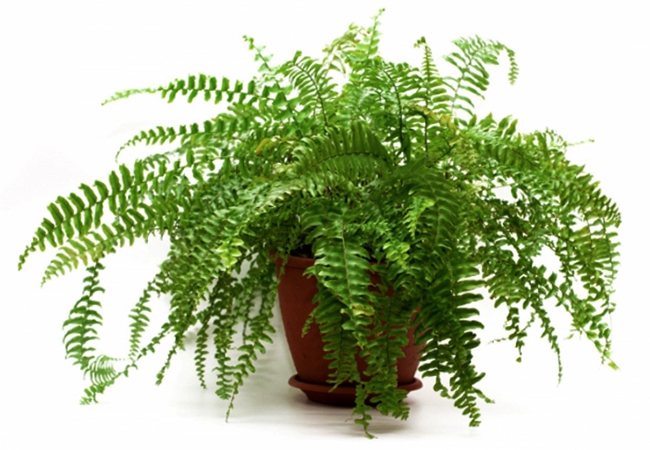

Better post it on a special stand... The flower grows, the pot becomes cramped for him. Therefore, he periodically needs a transplant. Spring is a good time for this. It is necessary to use soil with peat, rotted needles. Be sure to use drainage.
Fern characteristic
The fern family includes about 10,560 plant species. They are common all over the world and may vary in appearance.
The indoor fern, like its other species, is unusual in that it does not have seeds. But near its roots there are sori - spores that allow it to multiply.
The leaves of the plant are dissected and feathery, they have a light green color. The height of the fern is from 30 to 90 cm.
There are many types of ancient herbaceous perennials. The most common indoor types:
- Platizerium;
- Polypodium;
- Nephrolepis;
- Blehnum;
- Davallia;
- Asplenium;
- Maidenhair or verin of hair.
The most common type of ancient plants in Russia and the countries close to it is the bracken fern. It can be recognized by the feathery fronds growing in different directions.
Due to the similarity of the cut of the stem with the eagle, located on the state emblem and the similarity of the leaf plate to the wings of a bird, the plant is called eagle. But what are the benefits of the Pteridium aquilinum fern?
The plant is used in cooking, and in eastern countries it is a delicacy.
But in the cooking process, it is important to observe certain conditions, since the perennial is poisonous. You can only eat young shoots after special treatment.
Negative omens
According to popular superstitions, a fern brings negative energy to an apartment and is considered an energy vampire, capable of taking strength from the household around him. There was such a belief due to the fact that many who were nearby with a potted flower began to experience headaches. However, scientists have found an explanation for this popular superstition. Its leaves are really capable of taking up a large amount of oxygen at night, so if you are not ready to wake up every morning with a headache, you should not place the flower in the bedroom.
Some people are allergic to the spores of fern leaves, which is in no way connected with its magical witchcraft, but is explained from the point of view of medicine by the usual specific reaction of the body.
Among the supporters of various superstitions about the fern, many prefer to keep this flower not in the apartment, but in the office, and use its ability to absorb energy for good, promised by folk signs. For this, office workers put pots with an ornamental plant in the area of placing electronic devices so that the flower works as an air purifier and absorbs all radiation from computer equipment.
Useful properties of ferns
Indoor species absorb electromagnetic radiation and absorb dust. The plant owes its many medicinal properties to its rich composition. It contains tannins, starch, essential oils, flavonoids and alkaloids.
Fern shoots contain vitamins, carotene, tocopherol, trace elements and riboflavin. They are also rich in proteins and well absorbed by the body.
The health benefits after using fern-based products are to strengthen the body, improve the functioning of the nervous and digestive systems. The plant normalizes the functioning of the spleen, activates metabolic processes and eliminates headaches.
Some studies have shown that the home fern removes radionuclides from the body. And in China, it is used in the treatment of infectious hepatitis.
For therapeutic purposes, the roots of the plant are most often used. Often, tinctures and decoctions are used externally for:
- eczema;
- abscesses;
- scrofula;
- inguinal hernia;
- joint diseases;
- varicose veins and thrombophlebitis.
Products containing fern rhizomes have a powerful anthelmintic effect. They are effective for hymenolepiasis, diphyllobothriasis, porcine and bovine tapeworm.
For men and women, fern is useful in that it quickly eliminates inflammatory processes in the genitourinary system, which is confirmed by the reviews of many people who have cured prostatitis and adnexitis. With regular use of fresh leaves of a forest plant, the development of radiation sickness and leukemia can be prevented.
Despite the numerous useful properties and contraindications, medicines containing fern roots are used for cholecystitis, sciatic nerve inflammation, pleurisy, enuresis, convulsions, and epilepsy.
And to get rid of insomnia, traditional healers recommend sleeping on a pillow filled with plant leaves.
Why esotericists do not advise keeping it at home?
- Opponents of the fern are sure: this plant is a real energy vampire. And the larger and juicier the fern grows, the more mental strength it has stolen from the people around it.
However, in this regard, the plant can be rendered harmless! If it grows in a house (apartment), put it near the TV, let the Novosti program feed on it.
- You can not put a flowerpot with this plant in the hospital. Although it "drinks" the negative energy of a person, sick people are already exhausted, the green "vampire" will tire them even more.
- There is also an opinion that this forest dweller is too mystically difficult, so it is better to leave him where he grew up, that is, in the "bear's corner". Otherwise, the house (yard) can be filled with continuous failures.
- Esotericists say: for some people, indoor fern causes rapid fatigue, as well as frequent illnesses.
But doctors have already found a pragmatic answer to this mystical question! The fact is that the plant absorbs a lot of oxygen, so keeping it in the bedroom overnight is not worth it - it will end up with headaches. And besides, it is contraindicated for allergy sufferers because of the spores secreted by the leaves.
Potential harm
If we talk about a houseplant, then there is practically no negative impact on the human body from it. But there is an opinion that ferns are energy vampires, and their presence in the house leads to failure and disease.
There is a scientific explanation for this. It's all about the structure of the plant: spores collect on the lower part of the leaves, which can provoke an allergic reaction.
Another nuance is that the fern absorbs oxygen and emits carbon dioxide, which often causes headaches. Therefore, it is not recommended to put the flower in the bedroom, in particular next to the bed.
The plant can become the most harmful when used internally, as it is poisonous. Contraindications to the use of fern:
- pregnancy;
- kidney and liver diseases;
- childhood;
- weakened immunity;
- tuberculosis;
- anemia;
- acute gastrointestinal diseases.
Internal medication based on fern is contraindicated without prior medical advice. With intolerance or abuse of funds, acute intoxication may develop.
It manifests itself with convulsions, rapid heartbeat, vomiting, fainting, nervous disorders, and impaired kidney and liver function.
Negative values
- It is believed that the fern takes energy, and lives at the expense of the surrounding world, including people. Therefore, it is not recommended not only to grow it near the home, but also to keep it in pots in the bedroom. If you really like the flower, then it is better to identify it near the TV or computer.
- Fern spores are capable of absorbing oxygen. For this reason, it is not recommended to grow it in a home or near living quarters where there are children or people with allergies. In addition, many begin to ache near this plant, general health worsens, and headaches appear. Bouquets with leaves of this flower should not be brought to the hospital.
- There is an opinion that the fern is fueled by the energy of people in the house, so they begin not only to get sick, but also to quarrel. Discord and discord begins to occur in the family.
- If you have a plant in your apartment, then watch it for a while. When it has a blooming and healthy appearance, and everything is in order in the family, it means that energetically it suits you and your loved ones. There is no need to be afraid of him. On the contrary, the fern serves as a talisman at home. Just assign it to a balcony or loggia, you can take it to the country.
- But when next to a flower you feel bad, there are pains, nausea or dizziness, then it is better not to grow it either in the apartment or in the yard. In the old days, it was believed that his place was in the forest, in the "bear's corner", where he should not be disturbed.
- There is also such a thought: if a fern bush has been growing near your house for many years and has turned into a real giant, then you should not get rid of it. He probably protects you and your household from everything bad.
You should not keep a fern in a small apartment, in a bedroom, because it really absorbs oxygen and can impair health. Moreover, there is no need to carry it to the hospital to a person weakened by the disease.
But in the yard, at a temperature of +10 - 20 degrees, in a sunny place, the plant will decorate the summer cottage, and will serve as a magnet for attracting funds, and also always show if there is a negative on you or loved ones. Well, if you believe in omens, then the fern will also protect you from evil forces.
Application in traditional medicine and cooking
In the pharmacy, you can buy male fern extract in the form of tablets and infusions. And at home, on the basis of dried and crushed roots of the plant, they prepare medicinal decoctions.
In case of helminthic invasion and nervous disorders, 10 g of powder of dry and crushed raw materials is placed in water and boiled for 10 minutes. The medicine is drunk with honey, 10 ml at a time.
With varicose veins, a gruel of chopped fern and sour milk is applied to the affected areas. The compress is wrapped with foil and kept for 6 hours.
To strengthen the body, prevent cancer and improve digestion, fern infusion is suitable. It is taken before meals three times a day, 1 spoon.
Dry powder or fern extract, sold in a pharmacy, is used for inguinal hernia, inflammation of the appendages, oncology and jaundice. And with leukemia, it is recommended to consume salads daily with the addition of plant leaves.
Eagle fern is edible and is often used in cooking, especially in oriental cuisine. Its leaves resemble mushrooms in smell and taste, and its dried roots resemble baked potatoes.
Pteridium is added to various dishes - snacks, soups and bean curd. In Japan and China, it is fried and seasoned with walnuts. But the most common recipe for using bracken is Korean sprout salad.
Signs on the state of the plant
There are many signs and superstitions associated with the plant. If a fern growing in a house or apartment began to wither, this means that one of the ill-wishers tried to put damage or evil eye on those living in the room, and the plant simply absorbed all the negativity, warding off the trouble.


An exotic flower is a protective barrier against people with ill intentions entering the house. He will protect the home from evil spirits, evil spirits and other dark entities.
It is imperative for gamblers to have a fern in their home, as the plant will always contribute to luck, bringing huge winnings to its owners. Those who want to improve their material condition also need to have a magical plant in their home. It will bring prosperity and prosperity to the house.
The harm and benefits of fern to humans
It is believed that the fern is one of the oldest plants on Earth. It appeared in the Devonian period. In Russia, it was believed that any secrets and locks would be revealed to a person who found fern flowers. According to legend, the plant originated from the goddess Venus, who shed her hair. According to another version, the girl fell off a cliff, and a source appeared there, and her beautiful hair turned into a fern leaf that resembles a bird's wing.
Read also: Composition and useful properties of monarda, variety of applications and contraindications
Let's digress from the legends and consider how the plant grows in nature, as well as what you need to know before starting a home fern. Its benefits and harms have been studied since ancient times and, as people say, this plant is truly mysterious. Nevertheless, it is often kept at home, used in cooking and treated with diseases.
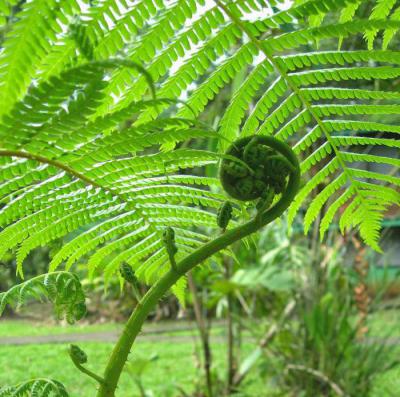

What are the benefits of indoor fern and is it fraught with harm
Indoor fern is notable for its beauty - its decorative openwork leaves invariably attract the attention of flower growers. It is grown as an evergreen and often grows in areas where others cannot cope with conditions, such as in offices with insufficient natural light. The bush does not like direct sunlight, tolerates shading well, prefers high air humidity and intense watering.
The lush greenery of the bush perfectly cleans the air in the apartment, removing harmful particles of formaldehyde from it, which are released in large quantities from paints, lacquer furniture coating. The plant is simply necessary for people who suffer from allergies. Placing a bush pot near a TV, microwave oven or computer can significantly reduce the amount of electromagnetic radiation emitted from appliances.
In addition, it is believed that keeping a fern in the house is a sign of wealth and well-being. Many believe that the plant has a positive effect on home energy.
Video "What is known about the fern"
In this video, you will learn a lot of useful information about the fern.
Benefits and useful properties
In addition to the fact that the plant decorates the room and purifies the air, there is also an unconditional benefit of the fern associated with a purely therapeutic effect on the human body. Even in ancient times, the plant was widely used in medicine for the treatment of various diseases. The useful properties of the shrub are as follows:
- has a beneficial effect on the metabolic process;
- relieves pain syndrome;
- used for cleaning from radionuclides;
- removes slags;
- used as a medicine for pancreatitis;
- has a tonic effect.
Medicines based on this culture are used as an antipyretic agent.
Now you know how fern is useful for humans as a medicine. But not everyone knows that the plant is used for food as ordinary vegetables: it is eaten raw, added to salads and sauces, salted and fried. In many regions, the edible fern is planted in large quantities for further export in processed form.
The Japanese know how to get starch from the pre-dried roots of an edible fern; the crushed root of the plant is used in confectionery.
Content flaws and harm
However, not everything is so cloudless. As with any question, there is a flip side to the coin: a plant can cause significant harm. So, on the back of the leaves of an adult bush, there are a large number of spores that can cause a severe attack of allergies in a sensitive person. In addition, the plant contains a small amount of toxic substances, and therefore there is a strict contraindication for the use of the shrub for pregnant and lactating women.
By the way, have you ever wondered why animals mostly don't eat ferns? The fact is that for most of them the plant is poisonous, the only exceptions are pigs, which gladly feast on starch-containing rhizomes.
The benefits and harms of indoor fern are purely relative concepts, and depend on the individual characteristics of a person and the subtleties of use.
If you are still wondering whether it is possible to plant and keep a fern at home, make a decision guided by intuition: you are unlikely to cook salads from the plant, so you are not in danger of poisoning. This means that the plant will bring nothing but benefit.
grow-
Bracken fern
The plant we are considering looks like a shrub. In nature, bracken usually grows in whole colonies. This is a tenacious plant capable of living even in rocky and sandy soil. If a fern once begins to grow in the country, then it is very difficult to bring it out, for which summer residents, of course, do not favor it. It is so tenacious that even after a fire that mowed everything around, it will be the first to give its shoots.
One of the herbaceous plants of the Osmundaceae family is the bracken fern. It traditionally grows in the Far East, China and Korea. In addition, it is found in Russia, Finland, Asia, Mexico, Ukraine. The plant consists of many stems with feathery leaves.
First, the fern begins its life underground. Here leaves are formed - fronds, which look like a snail. Then, as they unfold, they begin to resemble a hook. Reproduction of a plant does not occur at the expense of flowers, but at the expense of spores. It got its name from the resemblance of the leaves to the wing of a large bird. That is why the fern "Orlyak" is named. Its benefits and harms are revealed in many folk legends, which are retold from generation to generation to this day.
Soil requirements
If the fern was purchased from a store, the pot will already contain the most suitable substrate. If you need to plant a small sprout, you need to pick up the soil carefully. In the future, it must be used when transplanting.
The fern loves a loose bud with high acidity. Nephrolepsis will grow ideally in natural soil that can be taken from the forest. It should be humus with peat and leaves.
You need to add a little sand to the forest soil, and put expanded clay into the pot itself. It is very important that water does not stagnate in the ground, as this will lead to decay of the roots. If the soil is too dry, the plant will be covered with brown spots.
With proper care, the home fern will only be beneficial and will soon begin to delight the eye with lush vegetation.
Anyone who wants to grow a fern in the house asks himself many questions. Is it possible to keep a fern at home despite the signs? Can ferns be grown in the house? Of the total number of plants living on planet Earth, many beliefs and legends are associated only with the fern.
When the fern blooms
People have always been wary of him. In ancient times, they did not understand how the fern reproduces, since they did not see flowering. This time was expected as a holiday. There is a belief that the one who finds a blooming fern will become fabulously rich, since the Earth itself will show man its mysterious riches. For a long time people also believed that there is both harm and benefit of the fern. How is this expressed? This will be discussed further.


What signs are associated with a home fern?
- If you start it in your apartment (house), it turns out that the plant will begin to correct the indoor microclimate. There will be fewer arguments in the family, and outbursts of rage or anger will gradually subside. And the larger your family (and therefore, the more "cockroaches" every day dock, arguing on everyday topics), the more you need such a pet.
- Do you have an irascible temperament, and your spouse is a typical phlegmatic (or vice versa)? You cannot do without fern: it will help you find compromises.
- In addition, this plant can become an assistant for businessmen, business people. Esotericists talk about how people, whose business did not "shoot" for a long time, planted a fern in a flowerpot - and suddenly they made big money. And all - thanks to the adventurous "spark" that this plant engenders in the soul of a business person.
- Also, this "green friend" is turned on by players hoping to hit the jackpot in casinos or card games. But in this case, it does not always help. The fact is that the plant knows how to warn its owner against rash spending. But this is exactly what the purchase of chips in a casino is considered to be!
- Modern magicians say: in the garden, near the house, this modest bush is a living amulet. He protects the courtyard and the house from evil spirits, the tricks of evil witches. If he grows near your home, the malevolent person will not be able to cast a black charm on him (and on you).
- If the bush (even despite the care and regular watering) began to wither and finally wilted, it died for a reason. It means that damage has already been sent to you, and he took it upon himself.
Beneficial features
Today science can justify the benefits of fern in terms of composition. The plant is very valuable. It is rich in starch, alkaloids, flavonoids, essential oils and tannins.The shoots contain carotene, riboflavin, tocopherol and other useful vitamins and minerals.
It also contains many proteins, the same as in cereals. They are easily absorbed by the body and have a beneficial effect on it. The positive effect of the fern is seen in the work of the nervous system and in increasing the general tone. There is evidence that the fern helps to remove radionuclides from the human body.


Rhizomes are harvested for treatment in September. It is used for problems with the sciatic nerve, gastrocnemius muscle (cramps). Those who have tried fern treatment note the benefits of the course, which usually lasts three weeks. But remember: don't self-medicate. Before using any drug or remedy, you should consult a specialist.
Fern is famous not only for its beneficial effect. Its benefits and harms are most revealed in popular beliefs. This is what the article is about today. Let's take a look at how this plant is used in cooking.
Even in ancient times, fern was used for culinary purposes. Such species as ostrich and bracken, namely their shoots, are used for food. Leaves are also edible. They are good to add to salads or other dishes as a condiment. Fern shoots taste like mushrooms. They are very popular in Japan and Korea. It is a diet food. 100 grams of the product contains 34 kilocalories.
The plant is canned or boiled. Raw shoots, or, as they are also called, rachis, are not consumed, since they have a bitter taste. In cooking, the harms and benefits of the fern have also been investigated. As mentioned above, the plant is saturated with a variety of trace elements that can be valuable to the body, and quite the opposite.


The plant is boiled as follows: the leaves are placed in water, salt is added. Then they boil for several minutes, drain the water and pour in fresh water. Boil a second time until cooked. Finished rachises should not break, but bend easily. When this state of the shoots is reached, the water is drained through a colander and then the fern is used according to the recipe.
Salting is a favorite dish for many housewives. The workpiece will not deteriorate for a long time and will retain all its useful properties. Its preparation is very simple: a fern is placed in layers in a glass jar, not forgetting to fill it with salt every time. Then the jar is covered with a nylon lid and left for two weeks in a cool, dark place. After that, the brine is drained and the shoots are transferred to another container, only in the reverse order, where the top layer should eventually turn out to be the bottom. The jar is poured with brine, on the basis that the salt should be 22%. Then they are rolled up with lids and stored in a dark and cool place. The workpiece can be eaten for several years.
The harm and benefits of the fern have been studied for a very long time and it is about salting that the hostesses respond most positively, since they say that in this way the greatest amount of useful substances is preserved.
You can buy a blank of a plant. Before using such a product, it is first soaked for several hours so that the salt and bitterness are gone. Then the water is drained and poured fresh. After two hours, the fern can be boiled for a quarter of an hour without adding spices to it. The plant is added, for example, to fried meat at the end of cooking, cutting into pieces and leaving on the fire for a few more minutes.
There is a well-known recipe for cooking "in Korean". To do this, first stew separately strips of carrots and onions, then add fern with spices to them and stew for another quarter of an hour.
Read also: Karagana: general rules of planting and care - Landscaping
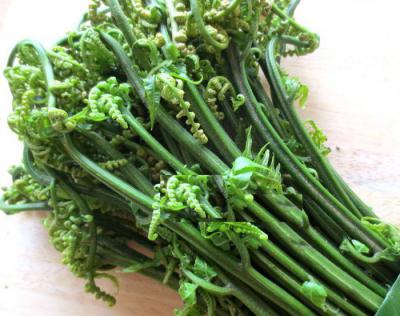

The harm and benefits of the fern are widely known in folk medicine. It is used as an effective pain reliever for, for example, joint pain. Baths with a decoction of herbs will help with rheumatism.Outwardly, fern is used for abscesses, eczema and scrofula. Also, decoctions from the plant are used to treat diseases of the intestines, spleen, jaundice.
Fern is an excellent anthelmintic agent. The acids contained in it are capable of killing all intestinal parasites. However, you should be careful when applying fern. Benefit and harm are adjacent to each other. And the latter manifests itself due to toxicity. Therefore, external use is safer when cramps, purulent wounds and rheumatism are treated.
At home, you can prepare a decoction of rhizomes. To do this, boil ten grams in two hundred milliliters of water, and drink a teaspoon of honey. You can also add flour to the broth. Sometimes, during treatment, an enema should be given or a laxative should be taken after the fern has been consumed. The health benefits and harms, as people say, manifest themselves immediately after application. The main thing is to use the remedy correctly, namely, only after consulting a doctor.
Fern in the house of omens and superstitions
In the apartment, the flower is a welcome guest, due to the fact that a lot of negative energy accumulates around the dwelling, seeping through the walls from the neighboring living quarters. In a private house, its own special aura is formed, connecting the house with the land and the surrounding nature. This makes it possible for the natural negative energy to enter the house, which the leaves of the plant accumulate in themselves. In its energy, the fern is similar to Dieffenbachia.
Private houses often become a haven for restless clots of energy. To prevent evil spirits from settling in the house, a peeled aspen branch is stuck in a pot with a plant. Fern at home is of great use in the lobby. Signs say that he does not allow people who come to bring negativity with them. At the same time, the flower attracts money and luck.
- The plant should not be placed in resting areas, since the discarded spores have psychotropic properties due to the poisonous properties of the plant. Spores can cause the development of an allergic reaction in the body.
- The leaves are a powerful stimulant. In ancient Russia, they were used as a decoction, rinsing with it while bathing. It was believed that within a few hours there was a surge of strength, vigor and clarity of thoughts.
- If several generations live in the house: adults, children, elderly parents, then the fern is placed in common areas: the kitchen, corridor or living room. It contributes to the fading of quarrels, disagreements and the emergence of mutual understanding.
- Fern helps in the house and businessmen. According to the signs, if you put it in your office, then it will certainly contribute to the birth of brilliant ideas that bring money to the owner. People who are keen on financial games often plant the bracken themselves in order to catch luck by the tail or the clivia flower.
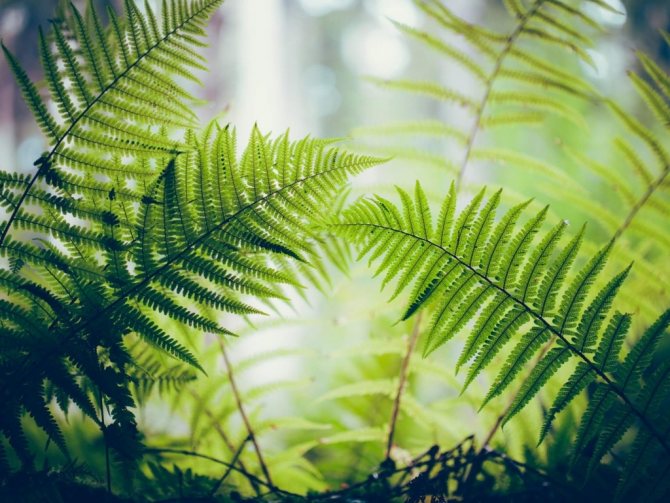

Is it possible to grow a fern at home
The fern comes from natural relict forests and does not take root well in artificial plantations. Usually, pots of an already planted plant are purchased, and after overgrowth, the question arises: is it possible to grow a plant in the house on its own.
It is difficult to answer this question unambiguously. Signs and superstitions say that it is impossible to keep a divided flower in the house, since after dividing it begins to absorb not negative, but positive energy of household members. As a result, people become weak-willed and lose mutual interest. The flower becomes a lovebird.
If the fern has grown strongly, it is better to transplant it entirely in the garden away from the home and start a new young plant. But you can take a young shoot from a flower in the garden and put it in the house. On the contrary, it will bring good luck, peace of mind and financial prosperity to the house.
Whether it is possible to keep a fern at home everyone decides on his own, since there is no definite answer. You can start it and observe the condition of the household.If the general atmosphere has improved, then it can be left as a talisman and an aesthetic component. If there is a deterioration in health or emotional state. This means that the flower is not suitable as a companion for residents.
Attention! Do not keep a flower in the house if negative situations and deterioration of health occur in its presence.
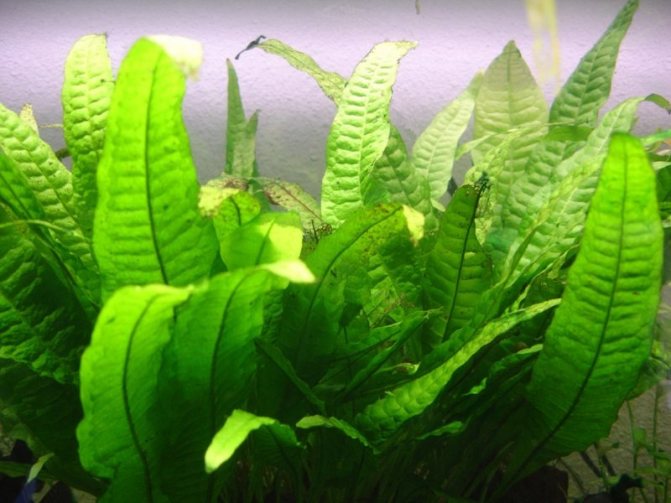

Contraindications
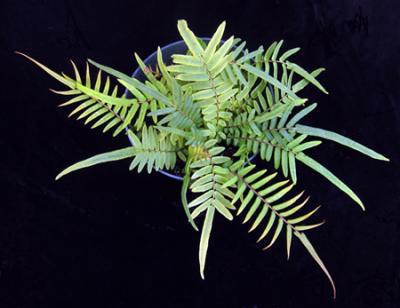

With the correct use of a plant such as a fern, the benefits to humans become obvious. At the same time, as mentioned above, the use of the plant should be strictly controlled, since it is poisonous and the harm from it will not be long in coming.
Fern is prohibited, for example, for pregnant women. In addition, the plant cannot be used for fever, kidney disease, ulcers, liver, tuberculosis and a number of other diseases, especially those of a chronic nature.
In case of an overdose, be sure to rinse the stomach and consult a doctor.
Fern in the country


Is it possible to plant a fern near the house in the country? It is believed that the exotic that grows under the windows of the newlyweds' house will preserve their tender feelings for many years, and also protect their love from envious people and spiteful critics.
The usefulness of a plant planted near a country house lies in the fact that it protects against various negativity, including the induction of damage and the evil eye.
The fern growing around the house will be an excellent defender against damage from the elements in the form of lightning, hurricanes and other disasters.
Home fern: benefits
And there is harm and benefit from indoor plants. People have known about this for a long time. Plants at home improve energy. The fern is also one of them. Many people believe that he is capable of performing miracles.
However, opinions on this matter are highly controversial. Some are sure that where the fern grows, energy improves, while others, on the contrary, argue that it brings some misfortune. If you look at him simply as a houseplant, it turns out that he is completely unpretentious and can easily live in the shade.
Those who believe in positive qualities say that the fern has a wonderful ability to pacify people. Aggressive and quick-tempered natures change their attitude to a more friendly and calm mood. Therefore, where family members often quarrel, it is recommended to have this plant.
The same goes for the general atmosphere. Harmony appears in a house with a fern. People also believe that the plant brings good luck in both personal and business life, as well as improves their financial situation. Previously, for example, very often a leaf of a plant was put in a wallet, believing that money would be found there more often with it.
Positive values
Many people love this plant very much, not only for its decorative characteristics, but also for the energy of peace and friendliness. For this reason, it is grown not only in the backyard, in gardens and flower beds, but also as a pot culture.
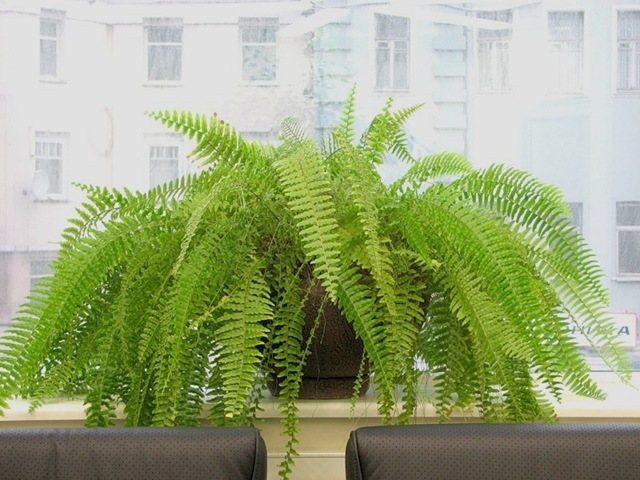

- In our troubled age, the fern bush helps to improve family relationships, harmonize space, bring peace and tranquility to the house.
- Often it helps to find a common language for different generations in the same family. Especially if parents, children and old people gather under one roof. Young people begin to respect their elders more, listen to their advice, see their wisdom, and adults try to understand the courage of the young and their worldview.
- The flower drives away all evil spirits from the house, as well as negativity, damage and the evil eye. Also for this reason, it is kept as a talisman.
- He helps to improve the financial situation. Some people believe that the fern brings good luck in gambling. But if you don't even play, then a fern bush near the house will help attract money into the house, which is important.
- With the help of fern leaves, you can check if there is damage on someone from the household. The plant always immediately reacts to the negative - it begins to wither and wither.
But there are also negative interpretations, which will be discussed below.Many growers do not plant or grow fern for several reasons, and also do not grow it in pots as a houseplant, preferring to admire the openwork leaves from the side. And there are reasons for that.
Home fern: harm
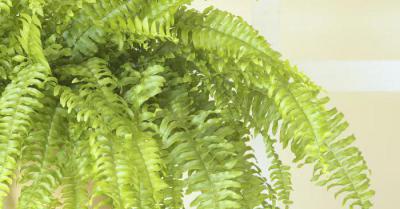

Before deciding whether or not to keep a fern in an apartment, the harms and benefits of the plant should be fully studied.
There is a point of view according to which this plant is an energy vampire that takes energy from family members, which makes them drowsy, tired and unhappy.
Those who believe in spirits should know: it has long been believed that along with the plant brought from the mysterious forests to the house, people brought with them all kinds of evil spirits, which also subsequently took away their energy.
How to make friends with a fern
If you want to believe in folk omens and the existing desire to make friends with a fern bush, which in some mysterious way acts as a source of attracting money to your house, you can simply choose the right place where to plant it at home.
We plant a flower at home
If you are worried that he too loves energy and oxygen will make you suffer from a constant headache, you should not plant him where you and your household often stay. Let the indoor flower find a place for itself on the balcony or in the corridor.
When growing a flower, always pay attention to its well-being, because its wilted leaves serve as an indicator that there is too much negativity in the house.
Some gardeners recommend installing fern planters in the kitchen, where they can be kept among the many microwave-emitting appliances, from microwaves to refrigerators and televisions.
Fern: description
As mentioned earlier, many legends and beliefs are associated with the fern. One of the most famous legends says that on the night of Ivan Kupala fern blooms in the wilderness of a dark forest. And the one who finds it and picks a flower will always be healthy, endowed with extraordinary power, and all the treasures of the world will be revealed to him. So far, luck has not smiled at anyone, since no one has yet plucked a flower of a wondrous plant.
The plant is very decorative, as it has openwork foliage, but in fact, one of its leaves is a frond, that is, a whole system of branches that are located in one plane. The most common and popular types of indoor ferns can be roughly divided into three groups. The first group includes fern species that do not require special care and cultivation at home. The names of these ferns are as follows: davalia, nesting brome, Cretan pteris, cyrtonium, nephrolepis and round-leaved lily.
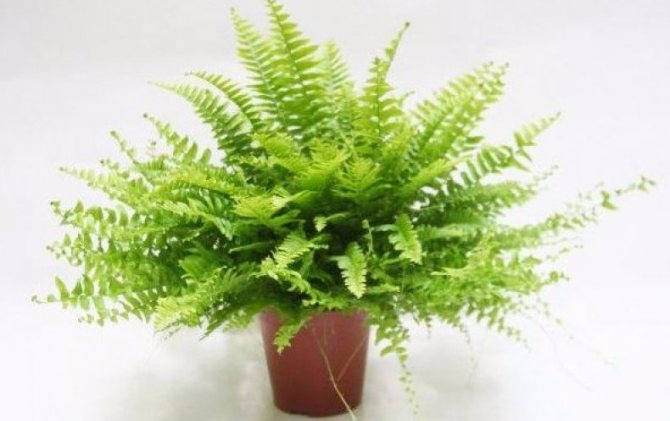

The second group includes ferns, which are conveniently placed in hanging pots or baskets. These are maidenhair and nephrolepis. The third group includes ferns, which are used as solitary plants. It includes humpbacked blehnums, nesting bonfires and nephrolepis.
Reproduction and transplantation of ferns
A plant transplant is required in cases where the flower does not fit into its pot, and is often done once a year in the spring. The soil for replanting should be loose and well-drained. Since fern is a forest plant, the soil in which it grows best should include a small amount of peat, decayed foliage or needles.


In the prepared pot you need to put pebbles or small stones on the bottom, add a small amount of sand to the ground. In order not to injure the roots of the fern, the plant can be transferred with the existing soil into a new container, and then add the required amount of soil from above and water.
During the transplant, you can also do fern breeding. To do this, you need to carefully examine the roots of the plant after it is pulled out of the pot.If there are small outgrowths in the root system, they can be carefully detached and planted separately. If there are no "children", you can simply divide the bush into two parts and plant each in a separate pot.
Thus, the conditions for caring for any species of fern are not particularly difficult even for novice amateur gardeners. But if you provide the right conditions for the flower, it will grow into a lush, bright bush, refreshing the surrounding air and delighting everyone who will have the opportunity to admire it.
Why fern is useful
Since indoor fern contains many different organic substances, it is believed that the benefits from it are very great. Ferns contain proteins that are very similar to those in cereals. The plant affects growth, contributes to the formation of the human skeleton, has a beneficial effect on performance, as well as on the activity of the nervous system. The fern contains about 4.5 g of proteins, 0.4 g of fat and 5.5 g of carbohydrates, and the total calorie content of the fern is 34 Kcal.
Read also: Pelargonium ivy: home care, bush formation, reproduction, diseases and pests
Why fern leaves are useful
The benefits of fern in food have been proven in many recipes around the world. Salads are prepared from fresh and young leaves of the plant, fried, pickled, salted for the winter. Also, dried fern leaves are used as a seasoning for meat dishes. The fern tastes like mushrooms.
Many chefs who use fern in their dishes claim that green shoots need to be cooked properly. They soak the shoots of the plant and salt to remove the harmful substances that are contained there, since the fern is a poisonous plant.
They begin to process shoots no later than four hours after collection. Fern stems are suitable for consumption, the length of which is not more than 10 cm. Those that are longer are considered not harmful, but not useful either. Green shoots should be used, since the overgrown ones contain few amino acids and trace elements.
Also in the practical use of ferns is infusion from its leaves. This is a good remedy for fighting fungal diseases, and it also works great against aphids.
Useful properties of fern root
Fern roots contain many beneficial properties that can surprise modern doctors. It is in them that unique medicinal substances accumulate.
The rhizome of the home fern contains starch, saponins, alkaloids, essential oils, fat, and all this brings great benefits to the human body.
This proves that the local people of New Zealand, as well as South America and Australia, often baked bread from flour based on fern root. Western Europe baked this kind of bread during the years of famine. Fern root flour has good taste, and the root itself tastes like a baked potato.
Nowadays, the fern is most often used in Japan and Korea. The roots are included in recipes for various salads, snacks, and as a seasoning, it is added to soups and bean curd.
Most often, fern roots are fried in oil and seasoned with walnuts.
Can this bush be planted in the garden?
This ancient plant has outlived dinosaurs and many other prehistoric animals. Some scientists say it is about 350 million years old. Unsurprisingly, the power of the fern is truly immeasurable.
Ferns are collected by healers and sorcerers. The latter are only from July to September, when the plant forms spores. It is believed that such a plant has the highest witchcraft power.
Most often they make amulets... They should be worn on a naked body to protect against the evil eye, damage and other harmful witchcraft. And if you spread the bags with the plant around the house (and higher and in the most secluded corners), you will protect your home and lure prosperity into the house.
Esotericists approve


- If you plant a fern in a flower bed located under the window of the house, you will protect your home from the encroachment of the same evil forces.
- And if you drop him off near the window of the newlyweds, the bush will protect this family from the bad advice of "friends", the bad influence of relatives. The love of such a couple will last for many years.
- And if the bushes are planted in the form of a circle, completely enclosing a house or cottage with them, your home will not be able to threaten a hurricane, lightning, downpour, hail and other bad weather.
- But even if the bush is far from the house, its "protection" will spread over the entire yard. This is also important - the fern will protect your flower beds, vegetable garden, garden, pets and birds from the evil eye. There is even an opinion that a green "shield" can scare off thieves from the courtyard.
- During "flowering" (that is, the maturation of spores, which occurs at the end of summer), the fern is very strong. He even can help you fulfill your cherished desire... It needs to be voiced while standing over a bush. Option two: write the wish on a piece of paper and place the note in the fern bush.
- By placing a bench or garden lounger near this plant and often resting there, you can get energy aid fern. The plant will "prompt" how it is possible to single out one, the true one, from the set of life goals, and go to it, without being distracted by the inessential.
- If your zodiac sign is Gemini or Aquarius, the fern, which is a kind of amulet for these signs, will help to achieve peace both in your own soul and in contacts with the outside world. And besides, the plant will help you discover many talents in yourself and successfully realize them.
And in addition, allergy sufferers can plant ferns in the garden. Here the plant will not be able to harm them with its spores.
When can it be dangerous?
Garden fern is a proud plant, it does not tolerate disrespect to itself.
Yes, there is a belief: anyone who dares roughly rip out a branch of a fern (vayu), or pull out the whole bush from the ground by the root, punishment will befall. A person will start unhappiness on all fronts - both on the family and on the worker.
The healing properties of the fern: how the plant is used in folk medicine
In addition to using the fern as a food, the plant is often used in folk recipes that provide invaluable health benefits.
The plant is most often used in folk medicine as decoctions and tinctures.
Fern is used to expel tapeworm from the human body. It will take two days to get rid of the tapeworm. On the first day, you need to consume only liquid and do not eat anything solid. Before going to bed, you need to take two tablespoons of castor oil and eat a few pieces of herring with onions. In the morning, instead of eating, you need to take one pill of fern medicine every couple of minutes for an hour. These pills include fern root powder, which is mixed with fern ether infusion from a syringe of 2 cm³. This mixture is divided into 30 servings. After taking, you should drink another spoonful of castor oil after 5 hours. This is because fern pills can cause the side effect of blindness. Then you need to take a container that will serve you as a toilet and pour warm milk into it. You will have to sit over it for a while, while you need to constantly push hard.
Fern is also of great benefit for humans with tapeworms and worms. It is the crushed dry leaves that help, but fresh fern can also be brewed. Put 1 tbsp in a glass of boiled water. spoon and boil the tincture for 15 minutes. Then the mixture is allowed to cool and taken within 4 days.
Fern root helps to get rid of varicose veins. To do this, use the crushed root and mix with sour milk. A thick layer of the resulting gruel is applied to the skin and tightly wrapped with gauze on top. They walk with her for about 6 hours.This procedure can be repeated, but only if necessary.
Fern is used in folk medicine and to strengthen the body. The tincture is made with vodka or purified alcohol. For one bottle, use a third of the crushed herb and take 1 tbsp. spoon 3 times a day before meals. This tincture improves digestion, fights cancer and strengthens both the body and the immune system.
Young fern shoots can also be brined. They retain their medicinal properties well in such an environment and are recommended for use in case of stress.
The use of ferns in medicine does not end with strengthening the body. The plant fights well with leukemia. To do this, you need to add 1 teaspoon of fresh or dried fern leaves to salads or soups daily. The course of treatment is 30 days.
Male fern roots are officially included in the pharmacopoeia and are used as a dry powder, decoction or extract. Dry powder, for example, is used for inguinal hernias in the form of a compress.
Fern is often used in the treatment of cancer, bowel disease, jaundice, ovarian inflammation, and as a diuretic, laxative and pain reliever.
Fern roots perfectly remove toxins and toxins from the body. It is used for eczema, ulcers, rheumatism, headaches and migraines.
Who is fern recommended for?
In astrology, it is believed that this particular flower can bring health and happiness to people born in the period from May 21 to June 20, that is, Gemini. The plant brings balance to life and harmony. Helps to make the right decisions, balances desires and needs.
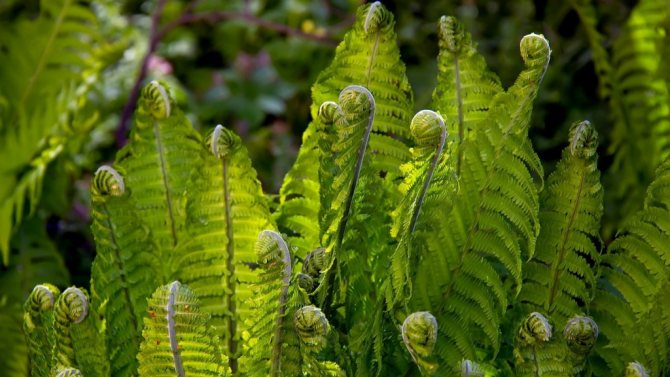

In the eastern horoscope, the fern is considered a totem plant for those born in the year of the Snake or Dragon. These people can safely grow their favorite plant not only near the house, but also in the apartment (with the exception of the children's room and bedroom). The fern bush helps them focus on serious issues, not make impulsive decisions, and helps in financial matters.
The ancient plant was also respected by the druids. They also recommended the fern as a talisman for people born on June 20th. He relieves them of the hustle and bustle, calms and brings inner harmony.
Positive action
- the fern of the house has a positive effect on the atmosphere in the living room, fills it with vital energy, harmonizes the state of mind of a person. This amazing plant can change people for the better, making them calmer and friendlier;
- helps such a plant to establish relationships in the house between people of different ages. Thanks to positive energy, relations between adolescents and parents are improving, children begin to understand adults and listen to advice;
- this amazing flower is able to scare away even evil spirits in the house. It is grown as a talisman, but if the leaves twist and wither, it is a signal that damage has been sent to the owner of the house;
- there is a belief that he can also attract money luck;
- if you believe folk signs, then this plant helps gamblers to win;
- there is a superstition that such a flower can warn the owners of the house against unwanted spending, thereby attracting cash flow;
- there is a sign that on the night of Ivan Kupala, you can protect your house or apartment from evil spirits and evil spirits with a fern. If the leaves of the plant began to wither instantly, this indicates that the flower has taken upon itself all the diseases and the negativity present in the dwelling.
Indoor fern, according to signs, is mainly beneficial, although there are beliefs that say otherwise.
Is it possible to grow a plant near the house
Many amateur flower growers are interested in the question, is it possible to plant a fern near the house? Why not, because the normal temperature for such flowers is 10-20 ° C, and they will feel great in the garden in a well-lit area.
Such a flower is very fond of water, that is, it requires a large amount of moisture for its growth. It is necessary to monitor regular watering and irrigate the leaves without fail.
Is it possible to keep this green-leafed flower at home, the decision is individual, but in any case, folk signs should be taken into account.
Proper plant care at home
Plants are unpretentious, but in order for them to grow actively and look beautiful, healthy, good, suitable conditions should be created for them:
- temperature;
- watering;
- illumination.
Indoor fern transplantation is carried out in the spring, but it is not required regularly. A transplant is only needed if the roots have grown and occupy the entire volume of the pot. Otherwise, you can just remove the top layer of soil a little and replace it with a new one. Fern soil should be light and loose. You can buy ready-made soil in the store, explaining to the seller what kind of plant it is needed for, or prepare it yourself. To do this, in equal parts, you can mix peat, turf and leafy soil, and also add a little sand there.
Ferns naturally reproduce by spores. But, in indoor conditions, this is difficult to do, therefore root separation is used. To do this, you just need to carefully divide the roots during the next transplant and plant them separately in pots. Before transplanting a room fern, it is necessary to fill it well with water so that the earth becomes sour, and the roots can be carefully untangled so as not to damage.
Where is the best place to put the plant
The fern can be placed both in the apartment and grown in the garden. In a house or apartment, the bush should be placed where the maximum congestion of people is noted. It will fill the home with positive energy and prevent unpleasant conversations, quarrels.
The bush can drive away bad thoughts. Signs indicate that the plant guides the owner on the true path, increases the chances of success and well-being.
At home, the flowerpot should be placed near electronic devices. The sheets purify the air and absorb negative radiation. Sleeping in the bedroom is not recommended to prevent headaches and allergic reactions.
Fern pots can often be seen in the buildings of public organizations. A pot on a desktop can transform energy for good. In addition, such localization contributes to career growth and improvement of the financial situation.
Is it possible to give a flower
Very often in modern floristry you can find bouquets containing a sprig of a fern. According to folklore, it is still better to get rid of such a twig in a bouquet. If the leaves of this plant are presented on the night of the holiday of Ivan Kupala, legends predict protection from dark forces for the whole year. Signs predict a win for avid gamblers who have received the coveted flower as a gift.
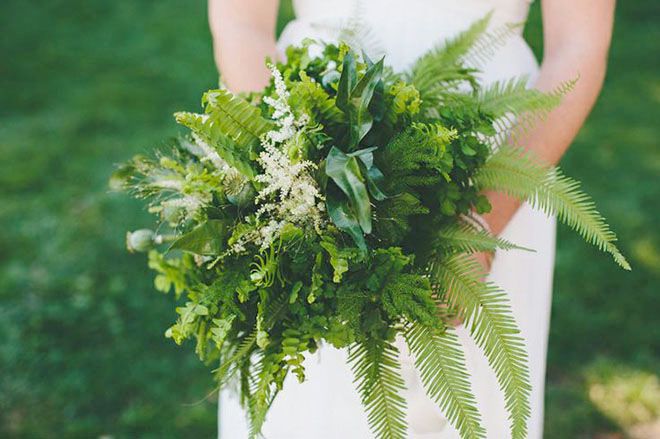

Signs regarding this ancient plant are contradictory in their content. In general, they predict favorable events, since ferns bring harmony, good luck and happiness to the house. A person creates an aura around himself. So let the magic bush bring good luck and tranquility to your home.
Is it possible to keep a fern in an apartment
Most popular beliefs answer this question in the negative. In fact, this is due to the fact that there was not enough reliable information about the plant. The assumptions were based on inexplicable deterioration in people's well-being. On the other hand, there were those who intuitively placed the flowerpot in the apartment correctly, while feeling good. So there were conflicting opinions about the indoor flower.
The fern in the house can be kept subject to the basic recommendations:
- It is forbidden to be placed in the bedroom.
- There must be an energy source nearby, such as a computer, TV, or other household appliances.
- The house should be free of allergy sufferers and small children.
- It is better to choose a place that is shaded, protected from the sun's rays.
- It is important to provide the plant with proper care.
Basic rules for keeping ferns
The temperature should not go beyond the following range: from +10 to +25 degrees Celsius. These are the upper and lower bounds.And the optimal range for this plant is from +15 to +20 degrees. If someone has met ferns in the forest, and more than once, he might have noticed that they like to grow in places where it is damp and dark. They love moisture, therefore, in room conditions, the soil should not be allowed to dry out. This requires regular watering, as well as spraying the leaves. In summer, when it is hot, watering is increased, in winter, it is reduced.
In the summer, the pot with the plant can be taken outside, but again put in a darker place so that the direct sunlight does not fall on the leaves. Otherwise, the leaves may get burned.
Meaning in dreams
The meaning of the fern as a symbol is revealed in different dream books. According to Freud, if a magic relic appeared in a dream, it means that novelty has disappeared in love. The dreamer suffers from monotony, dullness in bed and feelings. Intimacy seems insipid, unfulfilling. The relationship became calm and stable. This routine is both comfortable and depressing at the same time. You can try to get the paint back. The Dream Book of Plants confirms Freud's interpretation, pointing to the oppressive loneliness and humility of man.
Holding a branch in your palms is a sign of change. The withered leaves symbolize the end of happy days. It is necessary to be prepared for difficulties, troubles, illnesses. Problems can affect not only the dreamer, but also his family. A flower is worth getting for those who are not worried about allergies and headaches. You can plant it in the yard or at home in a pot. After acquiring a bush, you should monitor the well-being of the household and the plant itself. In case of discomfort, it is better to move the relic away.
The benefits of growing a fern at home
This flower grows well in houses with clean air. Indoors, it acts as a natural filter. However, if the air is heavily polluted, then the plant begins to wilt. Thus, it is also an indicator of air purity. If, with proper and proper care, the leaves begin to dry out, then it is possible that the cause is bad polluted air.
The plant is used in folk medicine. Medicines are made on its basis. It is also used in Chinese and Korean cooking, and luxurious fronds are used in floristry.
Fern on the site
If the room fern has ambiguous signs, then nothing prevents its cultivation in the garden, in the garden. Fern in the courtyard, signs and superstitions give the ability to protect the family, to harmonize relations between people.
Even if he grows up in the country, he will help eliminate conflicts between fathers and children, between spouses. So it is quite possible to plant it in the yard. At the same time, one must not forget about leaving. To bring positive things to the family, to life at home, he must feel great, his leaves must be fresh.
The ancient tradition of carrying its leaves with you as a talisman testifies to the positive influence of this plant. They were considered a shield protecting from various troubles.
Is it worth growing a plant at home
According to numerous beliefs, a fern is capable of bringing good luck to the house for some, while for others, on the contrary, a solid negative. In the old days, people argued that such a plant actively absorbs home energy, feeds itself only with good energy for normal growth and reproduction.
Such a flower can be grown at home, but it is advisable to keep it near household appliances (refrigerator, TV, microwave, and so on) in order for it to take away negative energy. Fern takes root well at home, despite the signs.
A large number of legends and signs alarms people, so they try not to plant this flower in their home.
Controlling plant growth
If a fern grows in your home, keep an eye on its growth and development. Any changes in the plant can speak of a positive or negative effect on the atmosphere of the house.If you believe the popular belief, then with a significant improvement in the appearance of a flower, you can be sure that it takes away diseases and brings positive energy to residential buildings.
If, while near the fern, you begin to experience any ailments, such as weakness, nausea, headache, and the like, it is better to take the plant outside.
According to existing signs, scientists have found that the fern is one of the few plants that is able to absorb positive energy from houses and take the vitality of people, so the best option would be to plant and keep the fern not in living quarters, but in garden plots.
Can ferns be planted near the house? Now we will try to find out.
Description of the plant
In nature, there are about 10,000 species of this plant. Ferns are mostly found in tropical forests. In Russia, their habitat is an ordinary forest.
Representatives of different species differ in size, have different life forms (appearance, which reflects their adaptability to the conditions of the growing environment), life cycles, structural features, etc.
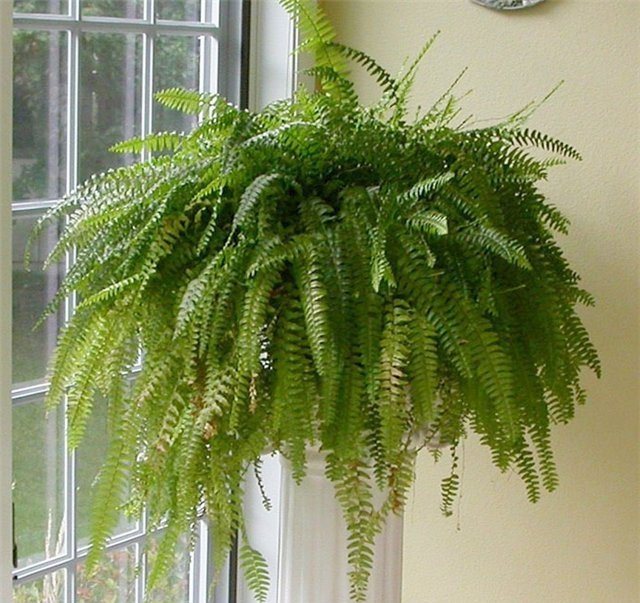

Is it possible to keep a fern at home
The fern leaf is not completely leaf. As a result of evolution, the plant has a leaf plate that resembles a real leaf, but, unlike it, has not yet been divided into a stem and a leaf. Therefore, what flower growers often call leaves, are correctly called differently: frond, flattened and pre-run.
The plant reproduces by spores and vegetatively.
Fronds grow from buds located on the rhizome. Their main functions are photosynthesis and sporulation. Spores are formed in sporangs located at the bottom of the flatworm.
A plant that attracts luck and money
Optimists and positive-minded people assure that a fern in the house is a sign of good luck and prosperity. Signs confirming this version read as follows:
- The fern can radically change the atmosphere in the house, where misunderstandings, mutual grievances and squabbles reign. He should certainly be "hooked" with large families, all of whose members have completely different characters that prevent them from getting along with each other. This plant is a master of “smoothing out sharp corners” in relationships, neutralizing negative energy, calming and pacifying. Helps to achieve peace of mind and mutual tolerance. For the same reason, the fern is perfect for people who are explosive, emotionally unstable, exalted, aggressive, angry, and prone to confrontation. It will absorb the maximum of negative energy, making a person more restrained and tolerant. He will help romantics to stop "hovering in the clouds" and learn to see real goals and ways to achieve them. This will raise their quality of life to a new level.
- The next sign is the main argument of the players in support of the green talisman. They firmly believe that this plant brings good luck in the game. However, the omen claims that the fern helps not only the players, but also all people endowed with a spark of emotional excitement and adventurism. For such enterprising and energetic people, the plant will provide good luck in business.
- Raising money is another trait of indoor fern. There are many stories among the people about how, after acquiring this herbaceous perennial, a person quickly and suddenly became rich.
- From ancient times to our days, there has been a sign that the fern is able to protect a person's dwelling from the effects of negative forces. With its help, people protected themselves from damage and evil eye. It is believed that if the leaves of a plant began to dry for no particular reason, then the "green keeper" of the hearth took on a magical blow intended for members of the family.
How to avoid the consequences predicted in the signs
To prevent unpleasant consequences, you should make friends with domestic fern.It is necessary to choose the right location for the bush, which will attract good luck and cash flows into the house.
The bush will bring good luck and happiness only with proper care. Florists note that care includes several features:
- Localization in close proximity to home appliances. This arrangement is necessary to absorb negative energy. Otherwise, the bush will take energy from a person.
- The location in the bedroom does not suit the flower. If this condition is not met, headaches and insomnia can be expected.
- The color of the leaves is essential. Green leaves are a good omen.
When growing a home flower, you need to observe the optimal temperature, which is 10-22 ° C. The bush does not like direct sunlight. Watering is carried out with settled water. Leaves need regular spraying.
Signs for planting and growing
It is much more convenient and reliable to keep this plant in the garden or vegetable garden. Only then cut off its long leaves to decorate the interior or form a bouquet, inserting beautiful and bright flowers. He is very comfortable in places where there is a lot of shadow space. Then the foliage becomes juicy, dark green, almost emerald.
In sunny meadows, when the condition of sufficient spraying is met, since stagnant water is very harmful, the fern feels great and surprises with its hairiness and unusualness. Fern roots are quite long and spread far, many children grow on each of them.
So that it does not completely fill your garden plot, sheets of construction slate or pieces of polyethylene are dug in around it. To decorate the summer cottage, ferns are brought out directly in flowerpots in the summer. They can be part of the outdoor interior.
Why fern is really dangerous
The fern can really represent a certain danger. Some of its varieties can be attributed to weakly poisonous plants. If leaves or rhizomes enter the digestive tract, it can lead to digestive upset.
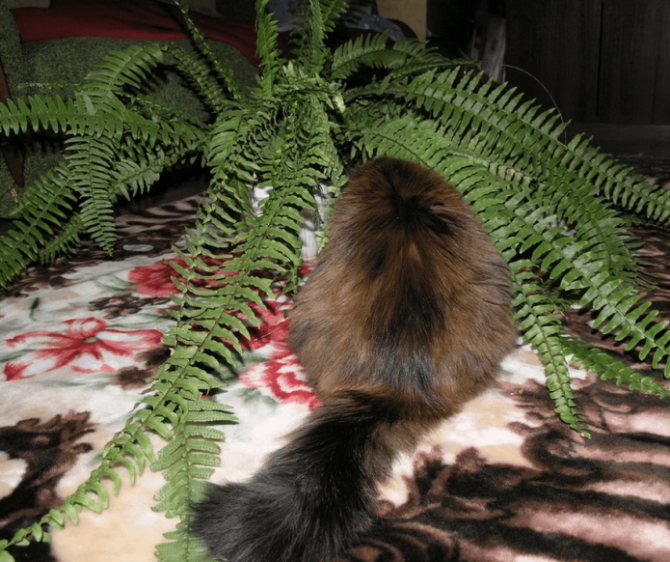

If there are small children or overly curious pets in the house, then it is better not to start ferns or, in extreme cases, to put them in the most inaccessible place
On the underside of the leaf plates of this flower, there are reproductive organs with spores, which, if inhaled together with air or in contact with the skin, can cause an acute allergic reaction or an asthma attack.
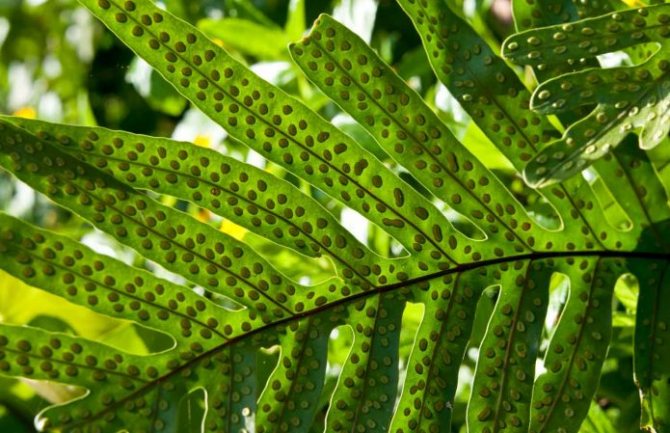

Fern spores can cause severe allergic reactions
Therefore, for sensitive and allergy-prone people, as well as for children, a fern in the house is contraindicated..
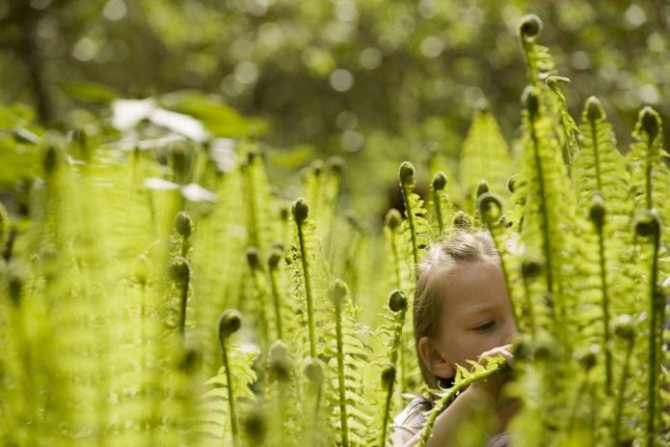

Do not start a fern if your family has children and allergies.
Even if the household does not suffer from allergies, you should not put a fern in the children's room or bedroom, it is better to place the flower in the hallway or living room.
Photo gallery: the safest options for placing a fern in the house
Plant value
In many countries of the world, the plant is treated positively. It is grown at home, fern leaves are placed in the apartment, because they can protect the house from evil spirits. In ancient times, in the culture of peoples, the plant possessed magical power, and this power could pass to man. There are a number of countries where the fern is a bad sign, attracts evil spirits into the house, and does not protect it. Also, people believed that the plant brings death and you can meet it in the cemetery.
People who keep green leaves at home will get sick, because they draw strength, positive energy from a person. Leaves live thanks to this energy and it will be so until the person dies or gets rid of such a vampire. If this happened and a fern appeared in your house, signs interpret that it is better to put it near the equipment, it is not recommended to keep it in the room where you sleep, since the plant takes oxygen, sleep will be bad, during the day, increased excitability, nervousness.
Influence on the human body
Signs explain that a fern can affect the human body both good and bad. It is important to consider what is inherent in a person's culture and faith. Folk omens interpret that in ancient times, people who had a positive attitude towards the plant believed that it could:
- Help resolve a conflict when a large number of people live together at home.
- Signs explain that the green leaves of this plant can affect a person's character, making him kind, calm.
- Helps people who love gambling. Signs interpret that in ancient times, players took a fern leaf with them to play in a casino, a hippodrome, races, to all places where they place bets. They also always kept them at home.
- They are kept at home, in large families, in order to stabilize and collect the energy of all family members into one. This action helps to avoid frequent conflict situations.
- Signs explain that if you keep fern leaves at home, you can improve your material wealth, attract good luck, peace, health.
When a fern appears at home, you need to monitor its growth.... If the appearance of the plant improves, then it brings benefits to the house, because it takes away negative energy and diseases. When you begin to feel weakness, nausea, headache, then the fern needs to be taken out of the house, as it gains strength from your energy.
What does the flower symbolize
Fern is one of the most ancient plants that appeared on earth thousands of years ago. The modern flower takes root well and grows at home. There are indoor and garden varieties.
There were legends about the bush and various myths circulated. Popular beliefs were described by Nikolai Gogol. People believed in the omen that if you pick a flower on the night of Kupala, you will be able to find a treasure that belongs to evil spirits. And the one who grows a bush at home will be lucky enough to attract good luck.
The bush is a relict plant and is 350 million years old. It increases vibrations, restores the aura. Leaves are usually harvested from July to September due to the appearance of spores. It is the disputes that indicate the acquisition of magical power, which is necessary for rituals. Amulets are also made from the leaves, which are worn on the body to protect against the evil eye. These charms can be laid out in different parts of the house in order to attract good luck.
The bush grows in many countries, which leads to the appearance of conflicting signs. The Slavs identified the fern with Perun and actively used it in various rituals.
People have different attitudes towards the house fern, which is associated with their culture and traditions. There is a sign that the home fern will definitely bring happiness, good luck and health. The plant also improves material well-being.
In many cultures, there is a positive attitude towards the house fern. The plant is placed in an apartment because of the well-known omen, according to which the leaves are able to ward off evil spirits. It was believed that the domestic fern has a special magical power that can pass to the owner.
In a number of countries, home fern is distinguished by bad omens. It is widely believed that the flower is capable of attracting unclean forces. And since the plant is often seen in cemeteries, the fern also symbolizes death.
According to negative signs, home fern draws strength and good energy. The plant cannot be placed in the bedroom. Otherwise, the person will suffer from insomnia, increased nervousness and excitability.
The magical properties of the plant
The nature of the magical properties varies, depending on countries and different cultural traditions. Since ancient times, people have believed in the following magical properties of the home fern:
- smoothing out conflict situations;
- positive influence on the character of a person;
- help in gambling.
It is noteworthy that avid gamblers were advised to take a leaf of home fern with them to the casino (to the racetrack or horse races). According to omens, a magical plant brings good luck and luck.
The growth of the home fern must be monitored. The good condition of the plant indicates the absorption of negative energy.
Experts also highlight the medical properties of a home bush:
- wound healing;
- elimination of hemorrhoids, rheumatism, pneumonia;
- treatment of the prostate gland.
Esotericists consider the bush to be a symbol of the purity of the human soul.
To whom and why the fern should not be kept at home
A spectacular plant is not recommended to be kept at home because of its properties. In accordance with the omens, the flower is considered an energy vampire, which takes a lot of energy from the surrounding space.
For a long time, the fern was considered a mysterious plant due to its growth in the thicket of forests. The sign said that if you bring beautiful leaves from the forest, you can expect failure and trouble.
People believed in imminent illnesses and constant fatigue, if you have a flowerpot at home. However, there is a medical rationale for the malaise. Allergic reactions may occur due to spores on the underside of the sheets. In the morning, a headache is often due to the active absorption of oxygen at night and the release of carbon dioxide.
Ferns in weather forecasting
Since our ancestors were largely dependent on the weather, they observed the behavior of animals and plants. These observations became the basis that formed various signs. For example, if the leaves of a fern curl downwards, it means that there is dry weather ahead.
Such a feature of plant omens can be interpreted as a harbinger of heat. Plants have been learning to anticipate the weather for millennia. Therefore, before the onset of drought, they try to save moisture. The ability to predict the weather is endowed with ferns that are at home, in the forest, and every garden flower has these properties. So the fern in your home can take over the functions of a hydrometeorological center.
Fern secrets
The fact that all indoor plants have an impact on the energy space is a long proven fact. Some carry negative energy, others - on the contrary, absorb it. But what happens if you keep a fern at home?
If you put a fern in the apartment, then you will soon notice that peace and harmony will settle in the house. This plant is able to smooth out conflicts, eliminate aggression, and even prevent quarrels and squabbles between household members.
Few dare to start a fern at home, and in vain. The plant is especially useful for people with the opposite temperament. He will calm down a too hot-tempered partner, and on the contrary, he will cheer up a more balanced and restrained partner, in a word, he will create a certain balance of relationships.
For lonely people, fern can help to achieve harmony of external and internal space, to balance mind and soul. It is not for nothing that the people called him “the flower of the golden mean”. The fern is able to reveal the potential of a person, help him to know himself and find his place in the sun.
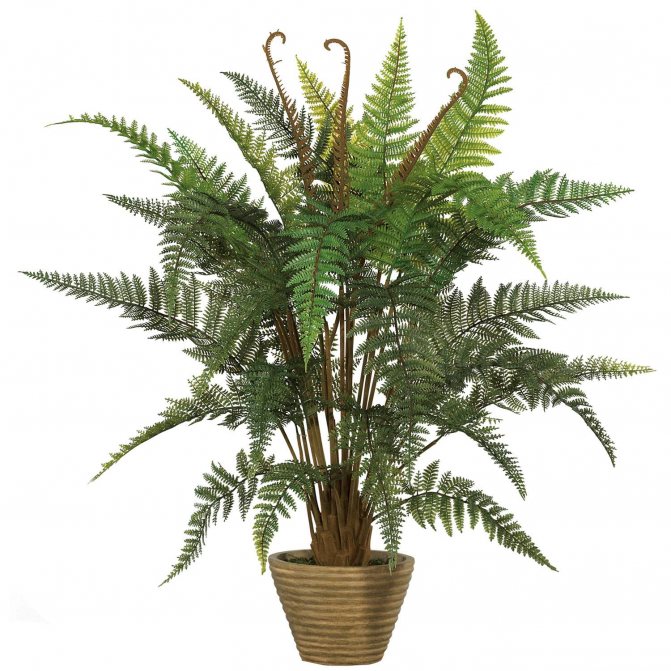

Is it possible to keep a house flower fern at home
For the ancient Slavs, the bush was a gift from a deity to a person. And since the power of the Deity is preserved in the leaves, they can transmit power to people. However, it is not possible to answer unequivocally the question of whether it is possible to keep a bush in an apartment.
Signs claim that the home fern has magical properties. The flower suggests the location of the treasure, and the seeds bring good luck.
If the fern is grown in the house, omens and superstitions can be positive and negative. Many experts believe that the plant has a positive effect on the atmosphere of the room. There is another opinion that predicts misfortune for the owner of the flower.
The plant in the legends of the peoples of the world
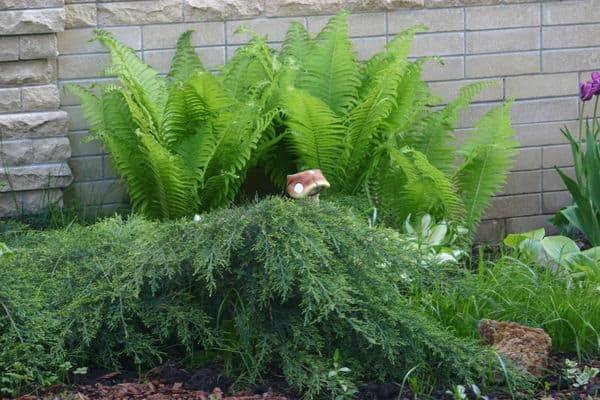

- The Slavs believe that on the Kupala night this plant blooms (once a year), and this flower helps to see the treasures buried deep underground.
- Modern Slavs (already well aware of how the "flowers" of most ferns actually look) say: if, during the period of dispute separation, tell your pet about your cherished desire, it may well come true.
- For the British, this plant is a love talisman. He is often turned on by romantic couples. Most of all, this "green friend" helps a man in love, so a guy from Foggy Albion can buy (plant) a fern at home, even if his chosen one does not reciprocate yet.
- Also, the ancient English (like the Russians, however) believed that if you find a fern flower, you can become invisible at will.
- In many Western European countries, they believed: these leaves can protect a yard or house from a thunderstorm. If there was no rain in the villages for a long time, they tried to cause it by cutting and burning the fern leaves. At the same time, superstitions warned: you cannot uproot a bush, nature will avenge this with a storm.
Fern and zodiac signs
- Astrologers consider this plant to be the talisman of Gemini. They are sure: if this “guest from antiquity” is planted in his house (garden, yard) by a person born from May 21 to June 20, the bush will be an excellent assistant in business, as well as a personal “harmonizer” (balancing the desires and needs of a person).
- As for other signs of the zodiac, fern is not harmful to them either. "Green pet" cleans the soul of unnecessary desires and experiences, directing thoughts from the secondary to the really necessary and important things.
- If we talk about the Chinese horoscope, then this plant is best suited for people born in the year of the Snake and the Dragon.
- Well, if you believe the calendar of the ancient Druids, it turns out that these sages are almost completely in solidarity with modern astrologers. Yes, the druids also believed that the fern is a lucky talisman for people born in the 20th of June. This bush gives them joy, relieving them of chaos and mental "mess".
And what can an experienced herbalist, that is, a herbalist, tell about this plant? Everything is in this video:


There are a number of plants that can bring both benefits and harm to a person and his home. There are those that are not recommended to be kept indoors, as they can attract negative energy. In different countries of the world, people treat this plant according to their traditions and cultures. There is a belief that the fern will bring good luck, happiness, health, help to improve material welfare, because this plant is not everywhere and not always can be found. It is a great success to find a fern during flowering. This must be done at night, on the holiday of Ivan Kupala.


In many countries of the world, ferns are treated positively.
In many countries of the world, the plant is treated positively. It is grown at home, fern leaves are placed in the apartment, because they can protect the house from evil spirits. In ancient times, in the culture of peoples, the plant possessed magical power, and this power could pass to man. There are a number of countries where the fern is a bad sign, attracts evil spirits into the house, and does not protect it. Also, people believed that the plant brings death and you can meet it in the cemetery.
People who keep green leaves at home will get sick, because they draw strength, positive energy from a person. Leaves live thanks to this energy and it will be so until the person dies or gets rid of such a vampire. If this happened and a fern appeared in your house, signs interpret that it is better to put it near the equipment, it is not recommended to keep it in the room where you sleep, since the plant takes oxygen, sleep will be bad, in the daytime increased excitability, nervousness.
Signs explain that a fern can affect the human body both good and bad. It is important to consider what is inherent in a person's culture and faith. Folk omens interpret that in ancient times, people who had a positive attitude towards the plant believed that it could:
- Help resolve a conflict when a large number of people live together at home.
- Signs explain that the green leaves of this plant can affect a person's character, making him kind, calm.
- Helps people who love gambling.Signs interpret that in ancient times, players took a fern leaf with them to play in a casino, a hippodrome, races, to all places where they place bets. They also always kept them at home.


Fern helps gamblers
When a fern appears at home, you need to monitor its growth.... If the appearance of the plant improves, then it brings benefits to the house, because it takes away negative energy and diseases. When you begin to feel weakness, nausea, headache, then the fern needs to be taken out of the house, as it gains strength from your energy.
In China, young children from childhood were taught many types of art and not only martial arts. Beliefs interpret that it was important to know herbs, plants, their functions and influence on the human body and the world around them. The flower was divided into one that brought prosperity, health and one that brought illness and misfortune. The teachings of Feng Shui helped the plants unite into one whole.
According to the doctrine, a flower such as a fern acts as a vampire for the human body, because it takes energy from the residents of the house, lives thanks to it, takes vitality. Signs interpret that often in a bouquet that is presented for a holiday and celebration, you can find a fern flower. It is not recommended to keep such a bouquet indoors. It is necessary to get rid of green leaves and leave ordinary flowers.
privorot-
The fern has long been considered a magical plant. There are so many legends about him! People believed that with the help of this flower one could find a treasure, and that its seeds would help attract good luck. Because of such superstitions, the question arises: is it possible to keep a fern in the house?
Fern at home: superstitions and omens
There are many folk signs about indoor fern. Some of them recommend not to grow it at home, while others, on the contrary, argue that this flower has a beneficial effect on humans. So, what are the signs to believe?
- It's believed that fern indoors has a good effect on the atmosphere space, defuses the tense atmosphere and harmonizes the state of mind of people. Fern at home, one might say, corrects people, making them softer and more friendly. So if passions and negative emotions are constantly boiling in your house, then plant this particular plant!
- Fern helps to establish contact between generations. There is a version that this plant has a good effect on the communication of people of different ages. Thanks to the energy of the fern, parents and children begin to understand each other more.
- Fern at home scares away evil spirits. Many people grew it as a talisman for the home. If the fern began to wither, it means that they tried to send damage or the evil eye to your house or to you.
- They say that fern attracts money luck. How true this is is unknown. But worth a try! What if you're lucky?
There are other beliefs and signs about the home fern that warn to keep it at home.
- It is believed that fern is an energy vampire. They say that for normal growth he needs a lot of energy, which he draws from the surrounding space. The negative effects of this plant can be avoided by placing it in the most energetically poor place, for example, next to a TV or other electrical appliances.
- Fern at home - to disease. This sign is easy to substantiate from a scientific point of view. Firstly, households may be allergic to this flower due to the large number of spores on its leaves. Secondly, the plant is distinguished by active absorption of oxygen, especially at night, because of this, headache can be caused in the morning. In this regard, it is not recommended to put the fern in the bedroom.
For some, a fern can bring good luck, for others it is not. It all depends on how you will use its magical properties. Good luck and don't forget to press the buttons and
Eastern teaching
In China, young children from childhood were taught many types of art and not only martial arts. Beliefs interpret that it was important to know herbs, plants, their functions and influence on the human body, the world around us. The flower was divided into one that brought prosperity, health and one that brought illness and misfortune. The teachings of Feng Shui helped the plants unite into one whole.
According to the doctrine, a flower such as a fern acts as a vampire for the human body, because it takes energy from the residents of the house, lives thanks to it, takes vitality. Signs interpret that often in a bouquet that is presented for a holiday and celebration, you can find a fern flower. It is not recommended to keep such a bouquet indoors. It is necessary to get rid of green leaves and leave ordinary flowers.

